Ways to Capture & Manage Business Information
The amount of business information an average organization manages has been increasing every year and is expected to grow 4.5X over the next two years. This information exists in both fixed structured form (spreadsheet or databases with tables of rows and columns) and unstructured form (contracts with client names and other pertinent information located somewhere in them, notes or conversations within a customer relationship management (CRM) record, or email that contains important information on a specific project). Effectively capturing and managing both structured and unstructured business information can increase employee productivity and provide more efficient operations performance.
Structured information can be captured into a document or information management solution in a variety of ways. Data can be manually input into a table, web form, or database or extracted from another application such as accounting or HR. Paper documents such as invoices, application forms, or shipping documents, which 70% of firms say comprise an important part of their business, can be scanned using a scanner or multifunctional printer (MFP) integrated with capture software. The capture software can be programmed to look at fixed tables or specific areas within the document and use OCR to extract that information into the document/information management solution. This automates manual entry of data and vastly improves the accuracy of business information capture. Additionally, metadata can be added manually or automatically to categorize the information and add other tags or bits of information to help in future searches.
Almost 60% of business information is expected to be in unstructured form. Unstructured information, as described above, does not have a fixed structure and resides in various formats such as emails, design documents, project management reports, legal filings, architectural and engineering files, audio files, videos, photographs, and a host of other forms including paper documents. Its value to an organization is usually based upon the context in which it is used in the file or document. As a result, capturing unstructured information presents a few more challenges but is not impossible using today’s capture and document/information management solutions.
Not all information in a document or file needs to be captured and managed, which is what presents the biggest challenge when dealing with unstructured business information. Document and information management solutions from solution providers like Centric Business Systems provide intelligent capture capabilities that can be set up to look for the following within the document or file:
- Patterns in text, numbers, or special characters. Examples include patterns of first letter capitalization in adjacent words, which can mean a first and last name of a client, number patterns such as the nine-digit pattern of social security numbers, or the $ sign, which could signal a monetary amount in an invoice.
- Preprogrammed terms. Client names, addresses, project identification numbers, and other terms a firm uses to identify records can tell the intelligent software exactly what to look for within the document or file.
- Repeating tables or lookup zones that have not previously been identified. Intelligent capture solutions can find pertinent information that appears in specific areas or tables of a document or file and suggest, or even create, a preprogrammed zone to look at in future similarly formatted documents.
Using artificial intelligence (AI) and machine learning (ML), many of today’s capture solutions can also learn to automatically add metadata based on the context in which the extracted information has within the document or file or kick off a workflow. These capabilities not only make capturing relevant business information from unstructured documents possible, they make working with structured documents even easier.
Effective business information capture from all types of structured and unstructured documents or files is the critical first step in creating a structure for information management policies that protect the information, retain it for future use, and make searching for it much more efficient; some studies show that an employee spends up to 2 hours per day or more searching for information! The document and information management specialists at Centric Business Systems can help you review your information management situation and suggest solutions from hardware, software, or services that can help tame the information chaos that may be arising in your organization today. Contact Centric at (877) 902-3301 or visit www.centricbiz.com to schedule an assessment and consultation.
